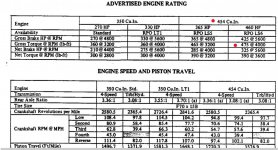You are using an out of date browser. It may not display this or other websites correctly.
You should upgrade or use an alternative browser.
You should upgrade or use an alternative browser.
1971 / 1972 Engine Output Options On An Automatic?
- Thread starter GCorvette
- Start date
GCorvette
CCCUK Member
It won't see a track or a strip, just looking for more torque on road use.Depends what you’re doing, the 1968 L88 ran the same basic drive train as the bottom of the range small block.
Roscobbc
Moderator
Improved engine 'breathing' is your answer. Cylinder heads are the very first area for attention. You need to look for port flow rates that give the best figures at lower and mid rpms. Camshaft selection needs maximise the benefits of the head design - ideally opening valves as quick as possible (within reason) - keeping open for as long as possible and closing quickly so you get the maximum cylinder filling. High valve lift doesn't always mean better cylinder filling. Carb size is relatively unimportant........if carb is jetted correctly engine will only take what it needs. Obviously a good dual plane inlet should be used (or better still MPI injection) A 'stroker' 383 cu in engine will yield great results with the above mods. Expect close to 400 hp.Thanks for that gents.
So, the 64 million $ question...
Which engine would be better to have for torque on a driver car or would (as James said) it be better to modify an engine to get the best balance between torque and fuel economy?
teamzr1
Supporting vendor
1971 and 72 were about the same in makeup
The real nut buster is the (RPO) LS6 which is a 454 CI at Gross and also
(GM used Brake HP ratings) 425 HP at whooping 475 lt/lb torque at 4,000 RPMs
Notice the 2 different carb brands and versions they used depending on engine and output
So you know exactly the design I am including below a GM engineering design and service manual, 165 pages of knowledge in a PDF
Also show the different in output as if having the auto or manual trannys
So make sure you click on it below and save this PDF and read it all this spring


Attachments
GCorvette
CCCUK Member
Fantastic, thank you.1971 and 72 were about the same in makeup
The real nut buster is the (RPO) LS6 which is a 454 CI at Gross and also
(GM used Brake HP ratings) 425 HP at whooping 475 lt/lb torque at 4,000 RPMs
Notice the 2 different carb brands and versions they used depending on engine and output
So you know exactly the design I am including below a GM engineering design and service manual, 165 pages of knowledge in a PDF
Also show the different in output as if having the auto or manual trannys
So make sure you click on it below and save this PDF and read it all this spring
CaptainK
CCCUK Member
Its interesting seeing the quoted GROSS and NET engine outputs in the picture above. Looking at the "270hp" base model, which would be what my 1968 327ci/300hp would be equivalent too (aka the base model). The GROSS HP is 270 vs NET 210hp, and torque is 360 lb-ft GROSS vs 300 lbs-ft NET. That kind of jives with my 327ci/300hp I had rolling roaded a while back and it was 245hp, and 300 lbs-ft, both of which would be NET as the engine is in the car and all the gubbins attached etc. So its kind of nice to know my car is roughly making the right amount of HP.
I do think new heads and a more fun camshaft might have to go in later on down the line though
I do think new heads and a more fun camshaft might have to go in later on down the line though
antijam
CCCUK Member
Interesting too to compare the max torque of the base 270 HP motor with the 'Hi-Po' 330 HP. The max torque of both is 300 Lbf-ft (net) but on the base it occurs at 2800 rpm whereas on the 'Hi-Po' it's at 4000 rpm. Bearing in mind that torque gives you acceleration and power gives you speed, the base, if just touring within our speed limits might be a more relaxed drive?
